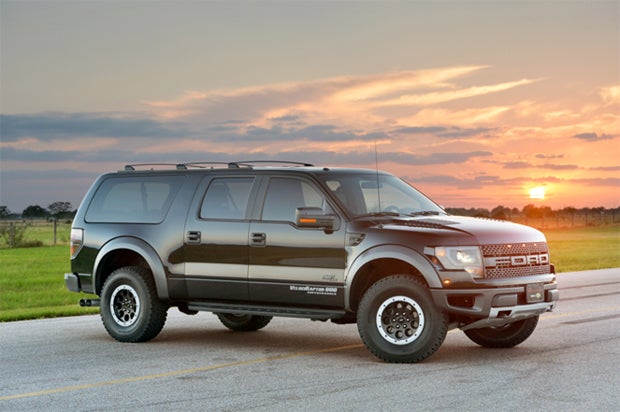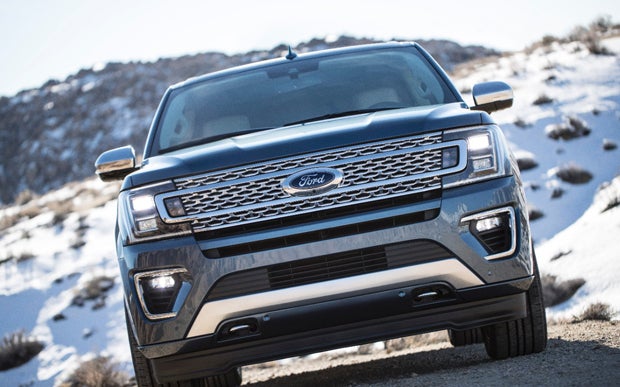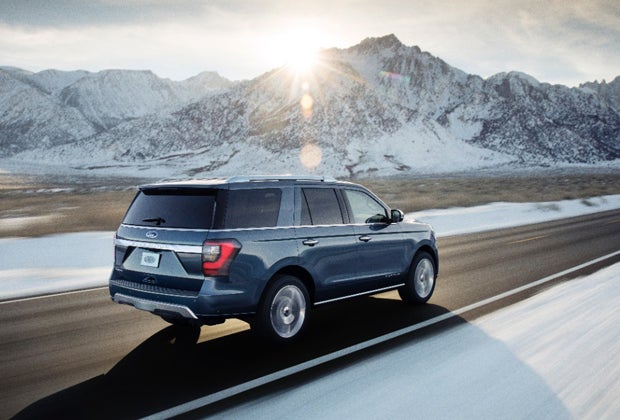
The Ford Raptor has been a runaway success. Since its launch in 2010, it has carved out a market niche unto itself. Ford does not report Raptor sales, but a trickle of information suggests the Blue Oval moves 1,000 or more of its Baja-rated trucks each month. That puts Raptor only slightly behind the 15,500 average annual sales of the entire Nissan Titan lineup. Raptor is a big deal for Ford, a powerful halo that thus far other manufacturers have been reluctant to replicate.
Given its enduring success and the recent Expedition redesign, is there a sound business case for Ford Raptorizing the Expedition? To understand just about any product decision an OEM makes, follow the money. And although we do not have access to the same data Ford does, letís take a stab at it.
What would be required to Raptorize Expedition and how much would it cost? The previous generation Expedition and Navigator shared Fordís T1 platform, a derivative of the T2 F-150 platform. The 2018 Expedition will likewise use an F-150 platform derivative. This time itís called T3, and like F-150, it makes extensive use of aluminum for its body-in-white as well as most exterior panels. The frame remains steel. Ford says the 2018 Expedition will be down 300 pounds versus the outgoing model.
The most obvious difference between the platforms underpinning F-150 and Expedition is their rear suspensions. Since its second generation, Expedition has featured an independent rear set up, whereas F-150 has retained its solid rear axle. Many off roaders scoff at the presence of an independent suspension, front or rear. And there are undeniable durability benefits to solid axles. But the market has adapted to IFS, with the exception of the holdout Wrangler, and even the Raptor has IFS. But would Ford adapt Expeditionís IRS or would it graft a Raptor solid rear axle to a Raptorized Expedition?
A Raptorized Expedition would be almost identical in weight to Raptor. But the Raptor Supercrew stretches across a 157-inch wheelbase to a total overall length of 244 inches. The standard Expedition wheelbase is just 122 inches with an overall length nearly three feet shorter than Raptor. If Ford elected to adopt a Raptor-like rear suspension, it would impact Expeditionís interior packaging and potentially rob it of its third row, or at least materially alter it. For this reason, we believe they would work within its existing IRS set up.

No matter what rear suspension solution they selected, the development effort would require an extensive effort to get it anywhere near Raptor-like wheel travel, articulation, and durability. Modifying Expeditionís rear suspension would likely be the single biggest expense associated with Raptorization.
The front suspension would also require attention; however, the similarities between the native setups in Raptor and Expedition suggest that the task would be less cumbersome. Body work, cooling, interior trim, and other changes would also be required. The F-150 that underpins the Raptor is not identical to Expedition. So although the Raptor could be used as a guide it would not simply be a donor.
Then there is the matter of propulsion. And here there is good news. The 2018 Expedition announced at Chicago includes a one-engine lineup, Fordís now ubiquitous 3.5-liter EcoBoost V6 mated to the same 10-speed transmission used in the Raptor. This is not the same tuned, high-output version of the 3.5 the Raptor gets. That said, we have it on good authority that Expedition will not be a one-engine nameplate; there will be an additional engine offering on premium trims.
We suspect that additional engine will be the same highly tuned EcoBoost as the one between the Raptorís front fenders. This makes sense as this solution would require little-to-no modifications to fit Expedition, plus it already uses the same transmission. Moreover, as trim inflation continues its seemingly inexorable rise, it would be odd for Ford not to take advantage by elevating the value of its high-end Expeditions by equipping them with more power. And finally, Ford already has the high-output 3.5 engine ready to go. They can further amortize its development cost by placing it in more vehicles. So the engine necessary to propel the Expo-Raptor is likely already on Fordís Expedition product road map.
What will it cost? This is more speculative, but if a midlife refresh typically costs $250-$400 million, then Expedition Raptorization will cost less than $200 million. And what is the Raptor development team up to right now anyway?
Demand is notoriously difficult to estimate. One challenge associated with creating a whole new market niche is accurately projecting sales. In fact, the best barometer for a Raptorized Expedition may be the Raptor itself. And therein lies what may be the most unfortunate part of this exercise. If most Exp-Raptor sales are projected to come at the cost of Raptor sales, the program would be dead faster than an engineer can open their CAD program. But truck and SUV consumers are not necessarily the same. Not only that, but SUV sales are hot. Jeep is about to launch the Wrangler pickup. Toyota has the TRD Off-Road and TRD Pro Tacoma as well as 4Runner.

How many Expo-Raptors would Ford need to sell without cannibalizing Raptor sales for the project to pencil? If the development cost were $200 million and Ford could move half as many Expo-Raptors as it does Raptors that would total 24,000 units over an anticipated four-year lifespan of the Expedition prior to its mid-cycle refresh. This formula suggests an additional development cost of $8,300 per modified Expedition.
Could Ford mark up an Expo-Raptor about $12,000 over a standard Expedition? Again, given the excessive trim inflation we see in the light truck market (F-150 now counts five premium trim levels), $12,000 does not look like an outrageous premium.
For those thinking the forthcoming Bronco may negatively impact this analysis, you have a point. But, as has been argued elsewhere, Bronco will be aimed at Wrangler and will thus feature a different off-road mission. The Expo-Raptor would be a desert-busting, high-speed off-roader, whereas Bronco will be a rock crawling go-anywhere machine. Moreover, the two SUVs, though both truck-based body-on-frame rigs, will compete in different size segments at different price points. For some of us, thatís the difference between a rig that fits in our garage and one that does not Ė mine will not accommodate a Raptor, but an Expedition, absolutely.
Will Ford develop an Expo-Raptor? Donít hold your breath, but considering the possibility is a delightful way to pass the time.
MORE FORD STORIES
2017 Ford Raptor Review
2019 Ford Ranger Prototype Photos
5 Things: 2018 Ford F-150 Raptor


 Your Privacy Choices
Your Privacy Choices